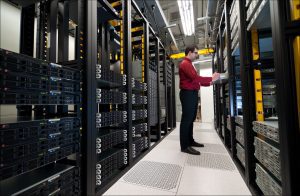In speaking with hospital stakeholders around the world, from C-level executives to operational managers, we find one of the biggest challenges to improving operational efficiency is the sheer complexity of the systems it takes to run their buildings. Adding to this, hospital executives and operational managers are working across multiple systems – patient room management, security, utilities management, energy management, and IT, to name a few. Traditionally, these systems have operated independently, making it nearly impossible for organizations to gain a holistic view of how resources are being used and spot opportunities to improve and streamline operations.
Technology is revolutionizing this traditional model. Hospitals now have tools to dramatically elevate how they measure, understand, and manage resources, the quality of care they deliver, and ultimately their bottom line. Tools such as Schneider Electric’s StruxureWare™ for Healthcare, which integrates a hospital’s systems, can help healthcare organizations transform from the status quo into a facility of the future.
For example, once completed, New South Glasgow Hospital will be the largest critical care complex in Scotland. This new world-class hospital is already using components of StruxureWare for Healthcare to integrate its systems, including HVAC, lighting, fire, security, video surveillance and more, creating an intelligent hospital infrastructure. This integration and intelligence is fundamental to achieving efficient and sustainable hospital energy management, but also holds the potential to optimize overall operations through data transparency, ultimately improving patient care.
New South Glasgow HospitalHospital managers can only control and optimize the resources they measure. A fully integrated building system built on an open architecture lets hospital managers use big data and analytics to identify and diagnose energy waste, potentially uncomfortable conditions for patients, and maintenance issues. And with graphical user interfaces and mobile applications, hospital managers and executives can view the data they need while sitting behind a desk or on the go.
An intelligent hospital infrastructure contains large amounts of data – data that can be used to run building analytics, which in turn gives operators the ability to identify and diagnose energy waste, occupant comfort, and maintenance issues. For instance, a diagnostic engine can automatically create a list of operational problems in the building according to the financial impact, while a dashboard provides a high-level view of diagnostic results across a building or campus. Users can then view the potential cost savings associated with repair or maintenance needs and operational changes, such as adjustments to control sequences. In addition, the impact of faults and opportunities in terms of cost, energy, comfort, and maintenance priority can be viewed over time to observe and analyze trends. These analytics support the implementation of continuous commissioning to maintain high performance and adherence to system KPIs.
Another example: an intelligent hospital infrastructure can help hospital organizations quickly and safely respond to adverse events through cross-system communication. For example, if a fire should break out in a mental health facility, the intelligent infrastructure can trigger a strategically planned response system that will:
- Identify the location of fire condition
- Notify staff in the vicinity
- Stage release of security doors
- Close smoke dampers on fire compartments to isolate the fire zone
- Modulate the ventilation air volume system by closing dampers
- Illuminate emergency lighting to direct people to exit doors
- Use a real-time location system to run muster reports to ensure staff and patients are out of harm’s way
It’s clear that innovative hospitals are now relying on data transparency and integrated technology to dramatically improve patient care, while also optimizing resources to meet organizational goals, healthcare mandates, and a difficult economic climate.
How are you applying technology within your own organization? What are some of the challenges or benefits you have experienced? Let us know in the comments section below or connect with us on Twitter at @SchneiderElec.
Want to learn more about the solution implemented at New South Glasgow Hospital? Read the press release.



Conversation
Hi Michael,
Good Morning,
I liked your thoughts and concur. We work with hospitals and other care providers and have observed similar challenges time and again.
Any chance you and me can connect? Write to me at avj@effectivemedtech.com
Regards
Ashok